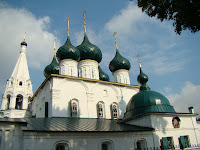 We awoke this morning to find our area covered in dense fog. Under Russian maritime rules, vessels come to a halt when the visibility drops below a certain level.
We awoke this morning to find our area covered in dense fog. Under Russian maritime rules, vessels come to a halt when the visibility drops below a certain level.(L - A passing ship comes out of the gloom)

This time we were lucky and managed to keep going. (Later we were forced to stop near and coming in to St Petersburg and also traveling across the White Lake to Goritsy - so in both
 cases the guides had to devise a Plan B, which they did very well.)
cases the guides had to devise a Plan B, which they did very well.)(L - As the mist started to clear we were treated to
 some interesting sights)
some interesting sights)(R - The sun climbed and burned off the fog - to give a beautiful day)
(R - At Yaroslavl we disembarked and boarded our luxury coaches for the day's events)

(L - In most Russian cities there is a statue of Lenin, the founder of the early Communist system)

(R - Church of Elijah The Prophet)
Yaroslavl is located 250 kilometers north east of Moscow. The historical part of the city, a World Heritage Site, is located at the confluence of the Volga and the Kotorosl Rivers. It is one of the Golden Ring cities, a group of historic cities northeast of Moscow that has played an important role in Russian history.
Preceded by Viking sites such as Timerevo from the 8th or 9th centuries, the city is said to have been founded in 1010 as an outpost of the Principality of Rostov Veliky. It is now about the 3rd largest city in Russia.

During the years of the Second World War Yaroslavl managed to escape German occupation of the city, since the Wehrmacht did not manage to break through the Soviet defence lines surrounding Moscow. Due to its location as a large transportation hub, and since the 1913-built railway bridge over the Volga in Yaroslavl was the only point at which to cross the river, the city became a major target for air raids during 1942-1943, and many buildings were completely destroyed. Most of the city's industry, including the automobile, tyre and textile plants, were converted, during the war, to produce armament and equipment for the Soviet Red Army.

(R - Our first stop was at the local Art Museum, which includes Russian Icons (XIII-XVII Cent), pictures of Russian artists of XVIII and XX, Cent, and masterpieces of ornamental art).which is set out as the home of one of the earlier nobles)

(L - We were welcomed by a small orchestra)
 (R - And our guides played the parts of the daughters of the House Owner)
(R - And our guides played the parts of the daughters of the House Owner)


(L & R - At our next visit, we saw a group of school children visiting the monument to the fallen from WW II - apparently this is a normal excursion on the first day back at school)

(R - One of the Churches here. We were quizzed about how old we thought that the Church was - we guessed 800, etc years. Surprise, surprise, it is about 5 years old. Being completely destroyed it has been fully rebuilt based on
plans and photographs)

(L - In 2011 the city celebrated its 1001th year since foundation - the park features the city crest along with the 1001 year picked out in flowers)

(L - In 2011 the city celebrated its 1001th year since foundation - the park features the city crest along with the 1001 year picked out in flowers)

(R - Near the view over the park, this iron railing carries many padlocks - a Russian custom for weddings when the couple lock the padlock and throw away the key to indicate their pledges. Unfortunately no one could tell us what happens if divorce occurs, and which is apparently at a high rate just as in the west)

(L - Another Church - I learned many more saints of the Russian Orthodox Church, which apparently has different rules for creating Saints than the Roman Catholic Church - and it is much easier!)

(R - On a more earthly note, the cross pieces of the crosses are covered in spikes to frustrate the local pigeons)

(R - On a more earthly note, the cross pieces of the crosses are covered in spikes to frustrate the local pigeons)


(R - We had free time to investigate the local markets - some undercover)

(L - And some in outside tents)
 (R - The Transfiguration Monastery)
(R - The Transfiguration Monastery) (L - The Monastery regularly holds competitions in campanology - this is the practice of ringing small bells - not like the large bells rung in Churches. We were entertained by one of the locals, with his own composition - then he offered CDs to buy!!)
(L - The Monastery regularly holds competitions in campanology - this is the practice of ringing small bells - not like the large bells rung in Churches. We were entertained by one of the locals, with his own composition - then he offered CDs to buy!!)
(R - We left Yaroslavl and continued)

(L - One of our on-board experts lectured us in the finer points of vodka)

R - After which we had to adjourn to the dining room, to sample five different types of vodka - gee life's hard - con't recall a lot of what else we did that day!!)

NOTE - I will finish up here, as we have long since left Russia and since then returned home. Thanks for reading!!



No comments:
Post a Comment